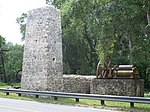Homosassa Springs Wildlife State Park
1964 establishments in FloridaBodies of water of Citrus County, FloridaNature centers in FloridaParks in Citrus County, FloridaProtected areas established in 1964 ... and 6 more
Springs of FloridaState parks of FloridaUse mdy dates from September 2022Vague or ambiguous time from November 2021Wildlife rehabilitation and conservation centersZoos in Florida

Homosassa Springs Wildlife State Park is located near Homosassa Springs, Florida, in the United States. The park is one of the notable locations in the state to view manatees. Visitors can get close to the animals on a floating observatory. Black bears, bobcats, white-tailed deer, American alligators, and river otters can also been seen in the park. The park is also home to the hippopotamus Lu, famously known for his performances in many movies for the past 40 years. The park is officially named Ellie Schiller Homosassa Springs Wildlife State Park in honor of Elmyra Felburn Schiller (1943 – 2009), a benefactor of the Florida state park system.
Excerpt from the Wikipedia article Homosassa Springs Wildlife State Park (License: CC BY-SA 3.0, Authors, Images).Homosassa Springs Wildlife State Park
West Fishbowl Drive,
Geographical coordinates (GPS) Address Nearby Places Show on map
Geographical coordinates (GPS)
| Latitude | Longitude |
|---|---|
| N 28.8 ° | E -82.588055555556 ° |
Address
Alligator Spring
West Fishbowl Drive
34448
Florida, United States
Open on Google Maps








